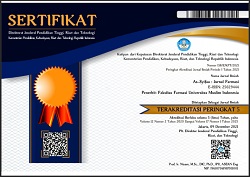PEMANFAATAN JAMUR ENDOFIT DARI DAUN MURBEI (Morus alba L.) SEBAGAI ANTIBIOTIK
Abstract
Endophytic fungi are fungi colonize internally plant tissue, without giving detrimental effect to the host plant. They act as symbiont, mediated plant resistance against biotic stress i.e. pests and diasease and abiotic stress such as drought and extreme of temperature. Endophytic fungi are one of the most creative groups of secondary metabolite producers that play important biological roles for human life. Fungi are among the most important groups of eukaryotic organisms that are well known for producing many novel metabolites which are directly used as drugs or function as lead structure for modification.
Mulberry (Morus alba L.) is one of the genus species known to have secondary metabolite compound that can be used as an antioxidant, antibacterial, antiviral, antidiabetic, antihypertensive, hypolipidemic, fever, flu, cough, antiemetic and gastrointestinal disorders. This research aimed to determine antibacterial activity of Mulberry Fungi from the leaves against the bacteria Escherichia coli and Staphylococcus aureus. Isolation of endophytic fungal carried by the direct isolation techniques. Isolates which produced as much as 3 isolates the MUR1, MUR2 and MUR3. Further isolates fermented using PDY medium and extracted using ethyl acetate. The ethyl acetate extract qualitative test the activity against bacteria Escherechia coli and Staphylococcus aureus. The result of the antibacteria activity, ethyl acetat extract from fermentation medium PDY of Mulbery (Morus alba L.) inhibited growth of Escherechia coli and Staphylococcus aureus at > 12 mm
Keywords: Endophytic fungi, Mulberry (Morus alba L.), Antibiotic.
Full Text:
Fulltext PDF (Bahasa Indonesia)References
Ali A, Kursia S, Nadia. Deteksi Antibakteri pada Ekstrak Daun Murbei (Morus alba L) dari beberapa lokasi pengambilan sampel tanaman di Sulawesi Selatan. Bionature 2016;(17):2.
Arora DS and Candra P. Assay Of Antioxidant Potential Of Two Aspergillus Isolated By Different Methods Under Various Physio-Chemical Conditions. Brazilian Journal Of Microbiology; 765-777.
Backman PA dan Sikora.. Endophytes an emerging tool for biological control potential of Bacillus mojavenis and related species. Biological Control 2008.
Butt MS, Nazir A, Sultan MT. Schroen K. Morus alba L. nature’s functional tonic. Trends Food Sci Techno 2008;19: 505-512.
Cadenas E and Packer L.. Handbook of Antioxidants. Switzerland: Marcel Dekker Inc., 2002.
Davis WW, Stout TR. Disc Plate Method of Microbiological Antibiotic Assay; Factor Influencing Variability and Error. Applied Microbiology, 1971.
Desmukh SV, Pathak and Takalikar DA. Nutritional effect of Mulberry ( Morus alba) leaves as sole ration of adult rabbits. World rabbit Sci J; 1993.
El-beshbishy HA. Singab AN, Snkkonen J. and Pihlaja K. Hypolipidemic and antioxidant effects of Morus alba L. (Egyptian mulberry) root bark fractions supplementation in cholesterol-fed rats. Life Sci 2006;78: 2724-33.
Elfallah WN, Tlili N, Nasri Y, Yahia, H, Hannachi and Chaira N. Antioxidant capacities of phenolic compounds and tocopherols from Tunisian pomegranate (Purica granatum). Fruits. J Food Sci 2011;76: 707-713.
Gibbons S. An Intoduction to Planar Chromatography. Totowa New Jersey: Humana Press, 2006.
Gurav S, Deshkar N, Gulkari V, Duragka N, Patil A. Free Radical Scavenging Activity of Polygala Chinensis Linn. Pharmacology Line 2 2007;245-253.
Hastuti US, Oktantia A, Khasanah HN. Daya Antibakteri Ekstrak Daun dan Buah Murbei (Morus alba L.) terhadap Staphylococcus aureus dan Shigella dysenteriae. in Prosiding Seminar Biologi, 2012.
Huang Y, Wang J, Li G, Zheng Z. Antitumor and antifungal activities in endophytic fungi isolated from pharmaceutical plant taxuz mairei, Cephalataxus fortune and torreye grandis. FEMS immunology and medical microbiology 2001;31:163-167.
Jin W, Na M, An R, Lee H, Bae Km, Kang SS. Antioxidant compounds from twig of Morus alba . Nat Prod Sci 2002;8(4):129-132.
Kaison O, Sinamompun S, Weerapreeyakul N, Meeso N. Phenolic compounds and antioxidant activities of edible flowers from Thailand. J Funct Food 2011;3 : 88-99.
Katsube T, Imawaka N, Kawano Y, Tamazaki Y, Shiwaku K, Yamane Y. Antioxidant flavonol glycosides in mulberry (Morus alba L.) leaves. Food Chem 2006;113:964-969.
Mc.Neil B and Harvey LM. Practical fermentation technology. Jhon wiley & Son Ltc England 2008;42:70-90,100-101.
Pietta PG.. Review: Flavonoid as Antioxidants. Journal of Natural Products 2000;63(7): 1035-1042.
Purwanto R. Peranan Mikroorganisme Endofit sebagai Penghasil Antibiotik. Jakarta, 2008.
Rodriguez RJ, White JF, Arnold AE, Redman RS. Fungal endophytes: diversity and functional roles. New Phytologist . 2009; 182: 314-330.
Schulz B, Boyle C. What are Endhophytes. Soil Biology, 2006.
Sun F, Shen LM and Ma ZJ. Screening for ligand of human aromatase from mulberry (Morus alba L.) leaf by using high-performance liquid chromatography /tandem mass spectrometry. Food chem 2011;126:1337-1343..
Verma VC, Kharmar RN, Strobel GA. Chemical and functional diversity of natural products from plant associated endophytic jamur. Natural Product Communications . 2009; 4: 1511-1532.
Zhao JL, Zhou J, Wang T, Shan L, Zhong. Fungi for producing bioactive compounds originally from ther host plants. In Current Reasearch. Technology and Education Topics in Applied Microbiology and Microbiol Technology, 2010.
Xiang L, Lu C, Huang Y, Zeng Z, Su W, Shen Y. Endophytic fungi from a pharmaceutical plant, Camtotheca acuminate: isolation, identification and bioactivity. World Journal of Microbiology and Biotechnology, 2007.
DOI: https://doi.org/10.56711/jifa.v9i1.254
Refbacks
- There are currently no refbacks.
Indexed by:
ISSN: 2085-4714 | e-ISSN: 2502-9444
Editor's Address:
Faculty of Pharmacy, Univeristas Muslim Indonesia
2nd Campus of UMI: Jl. Urip Sumoharjo km. 5 , Makassar, South Sulawesi, Indonesia
E-mail: jurnal.farmasi@umi.ac.id














